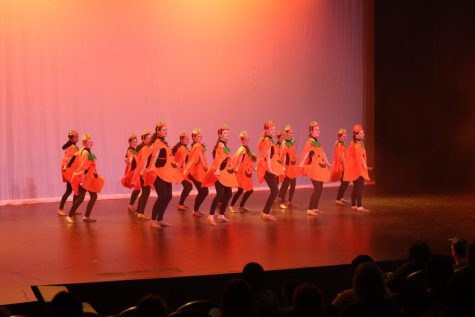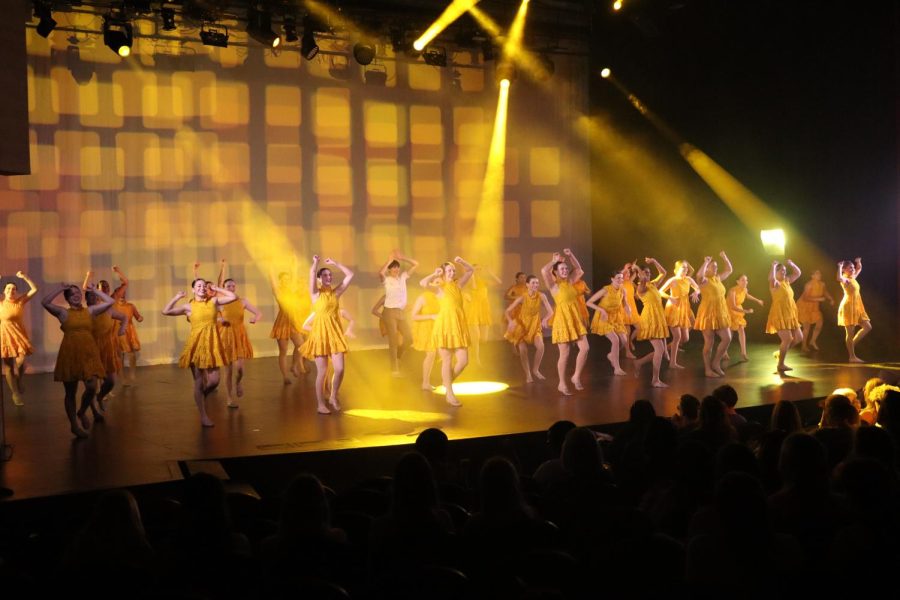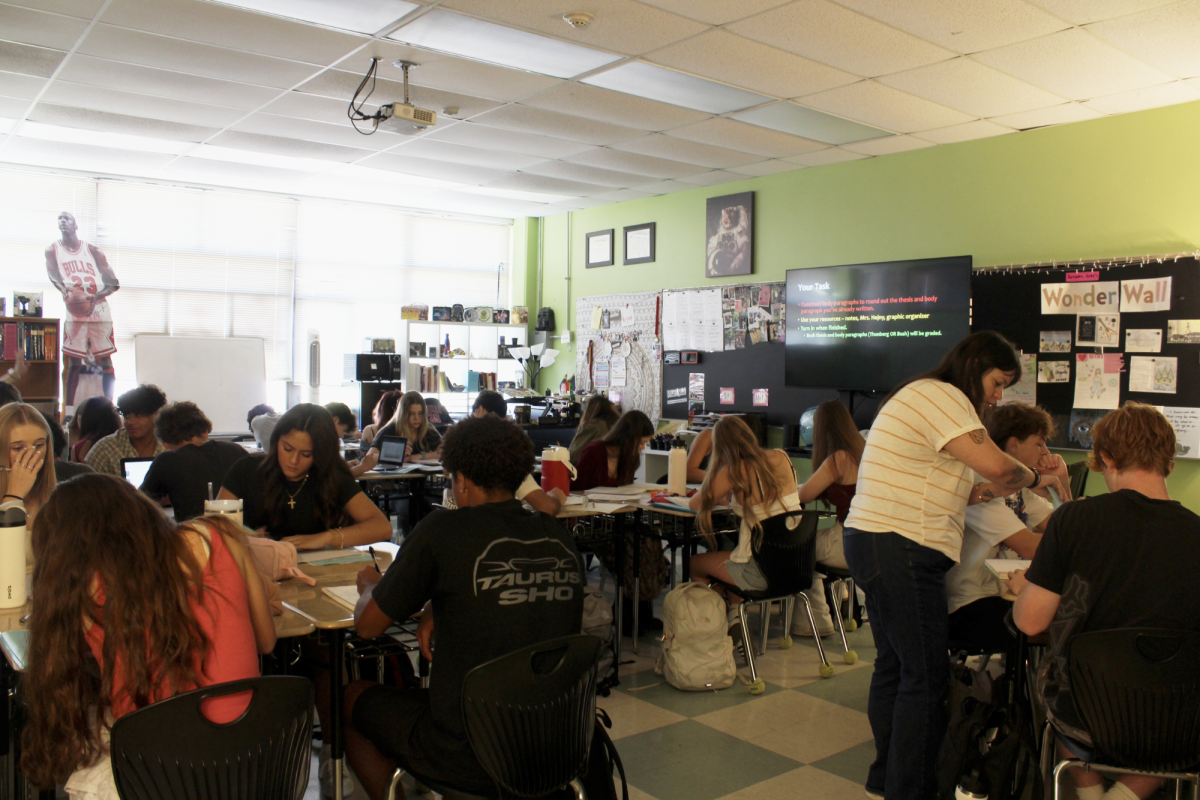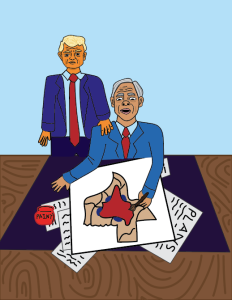Found in the Attic
Silver Stars host their annual Spring Show starring all members of the dance program
REACHING UP TO THE SKY: The Silver Stars perform the show’s opening number, dancing underneath golden spotlights. The show features all members of the dance program.
July 7, 2023
Spotlights shining, the crowd erupting in cheers, the Silver Star dance team takes their final bow on night three of their Spring Show, bringing an end to their season.
During the second semester of every school year the Silver Stars host their annual Spring Show, which stars all members of the dance program, including the varsity and junior varsity dance teams, and the dance classes.
“We do most of our contest dances, and then we also come up with new dances so we have more for the show,” senior Shay Gist said. “The show is basically to show off what Silver Stars and the dance program can do and have been working on throughout the year.”
The show featured over 20 routines, with varying styles including contemporary, novelty, and traditional kick.
“My favorite number to watch was the tap company routine,” JV Star Dancers Assistant Director Alyssa Paramski said. “It was so much fun. Their costumes were fun, their music was fun, and tap is just one of my favorite styles ever to watch on stage.”
Alongside the various styles displayed on stage, the show contains routines from the full team, the companies within Silver Stars, and solos from the Silver Star Captain and First Lieutenant.
“I was in 14 dances this year,” Gist said. “I would say I enjoy doing team dances better than a solo because I like feeding off of everyone else’s energy, rather than just being by myself. Solos are also just generally more difficult for me.”
Putting on such an extravagant show takes months to arrange, so the dancers begin preparing at the beginning of the second semester.
“The week of the show consists of two tech rehearsals. Those are about four hours long and we take act one and act two and divide it into two nights,” junior Peyton Nowell said. “During these we work with costumes and lighting. Then the day before opening night is a full run through of the show. Leading up to all of that we take all of our choreography and re clean it from competition. We also take time for the officers to teach choreography to the team for all of the new pieces.”
These tech rehearsals proved to be necessary, as the dancers were working with a new theater and stage.
“Getting the lighting right was difficult, with it being the first show in the new theater, and it being a lot bigger of a stage than we were used to working with,” Paramski said. “Ms. Bilnoski did a great job of just making sure that the lighting all looked really good and complimented the numbers, but that was definitely a challenge.”

Dancing on a stage provided other difficulties beyond the technical aspect, it directly impacted the routines.
“After the contest we have to re-block all of our dances so they fit on the stage because we’re used to doing them on a gym floor, and the stage is a lot smaller,” Gist said. ‘So we have to re-block all of those and then we learn our new dances. So we have practice every morning, planning all of the dances and then the week of the show we practice in the theater every morning.”
Every year the show has a new theme, this year’s being Found In The Attic, which forms the thematic basis for all the routines, costumes, and music used in the show.
“I think one of the hardest challenges for preparing for the show was finding things that are going to fit with our theme best,” Nowell said. “It was kind of hard finding music to put all of the numbers to and for the costumes because it was difficult to figure out how to make something fit with our theme since it’s kind of unique.”
After long months of preparation, opening night of the show finally arrives and the dancers are finding new challenges that come with the rapid pace of the show.
“For me the most difficult part was stamina,” Gist said. “Being in almost every other dance is very difficult and it’s hard to do the entire show with high energy and performance.”
For Gist and the other dancers who are in the majority of the routines, the short amount of time backstage in between numbers is very chaotic.
“I have one quick change, which is when I had two minutes to change costumes, which is really stressful,” junior Nikita Karivelithara said. “I think one of the other dancers had about four dances in a row. I think quick changes are something that quite a lot of the dancers had and it’s pretty stressful.”
In addition to performing, many of the dancers have their choreography featured in the show, especially the team officers.
“My favorite part of the show is choreographing the dances,” Gist said. “Officers choreograph a lot of the dances, so getting to show off our choreography is fun. It also gives us the opportunity to practice choreographing for a performance and showcase our depth as dancers.”
Since the show features many routines used during their contest season, the dancers are able to reflect on their prior competitions.
“I honestly prefer the Spring Show because you’re performing for your friends and family, which is less stressful than contest season when you’re also being judged and competing against other people,” Karivelithara said. “There’s less pressure during the Spring Show, because although you’re still performing and it’s still important, there’s no winning or losing. It’s just showing off your dances and performing for the fun of it.”
While the show is intended to display the talent of the dancers, it also highlights the directors and how they’ve developed the program.
“All of the directors through my time on Silver Stars have been so understanding and so willing and I’m so thankful for the trust they’ve shown me,” Nowell said. “Especially this year, now more than ever, because I’ve had a leadership position on the team. If it wasn’t for them giving me all the lessons I’ve learned and always doing everything they can to help me grow, I would not be the leader and the dance team member I am today.”
For the directors of the dance program, the show acts as a reflection of all the growth and progress made throughout the season.
“I just love getting to watch everybody work really hard to accomplish goals, get new skills, and put on a good show,” Paramski said. “I love getting to see how excited they are when they perform on stage and are improving. ”








